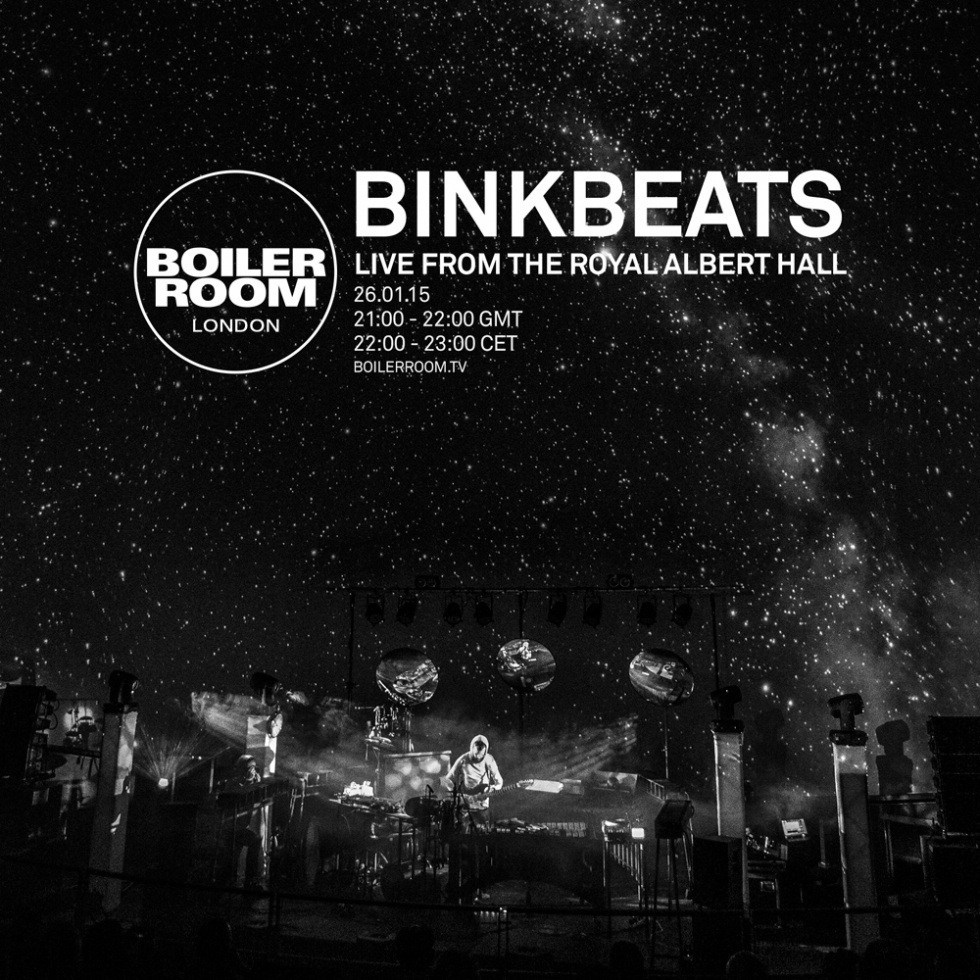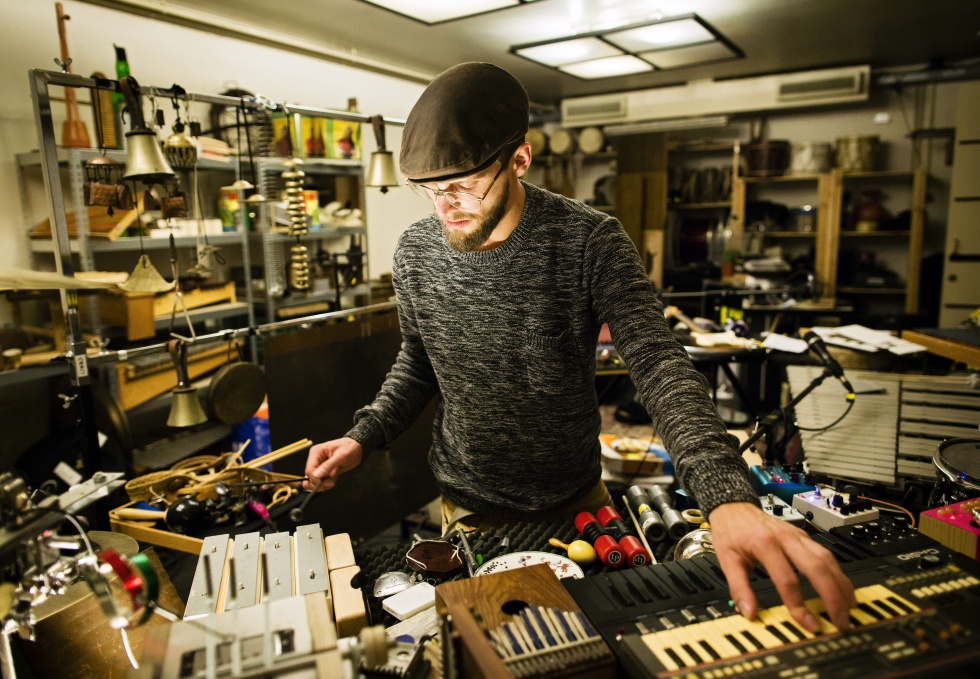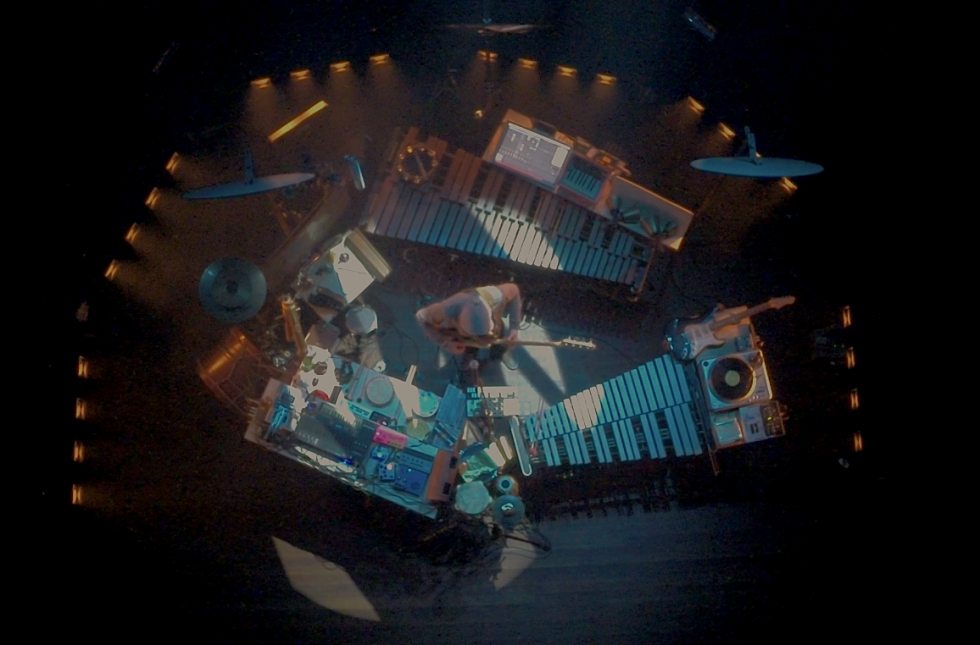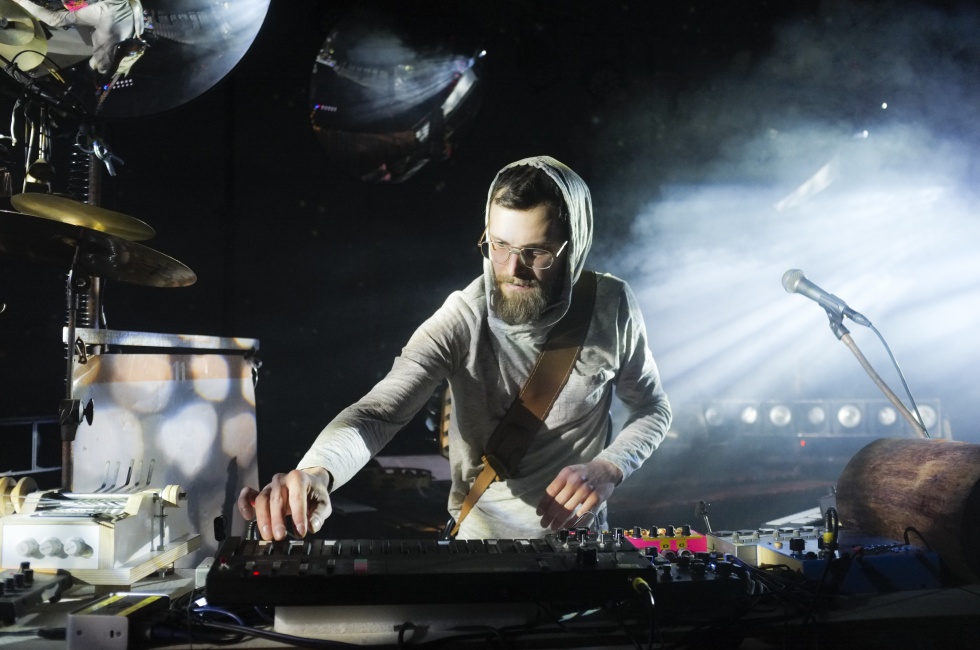 You’ve seen him; well, you probably have. His exploits have invaded countless feeds and timelines. The unnervingly talented Dutchman bringing an arsenal of hardware together with a cobbled assortment of everyday utensils to spin out freakishly accurate cover versions. A sonic parallel to Neil Buchanan from Art Attack (go with it). Something beats? Binkbeats? Yep, that’s the one.
You’ve seen him; well, you probably have. His exploits have invaded countless feeds and timelines. The unnervingly talented Dutchman bringing an arsenal of hardware together with a cobbled assortment of everyday utensils to spin out freakishly accurate cover versions. A sonic parallel to Neil Buchanan from Art Attack (go with it). Something beats? Binkbeats? Yep, that’s the one.
His one-touch track reconstructions would be an impressive YouTube distraction even if they were tackling unfamiliar tracks. But the added gambit that truly elevated Frank Wienk’s breakout Beats Unraveled series was his ambition in going after big game: Madlib, Thom Yorke‘s Atoms For Peace, Caribou; some of the greatest artists of all time. He gave himself breathing room by a covering a few acts to come up in the 10s, but let’s not kid ourselves: fuck up “Windowlicker” and you’re not getting away with it.
With a global name now made for himself, Binkbeats has skirted past the logical next step – i.e. resting comfortably on his laurels – and instead significantly ramped up the pressure by adapting his one-man-band spectacle to the live arena, blooding a glut of new material as well as letting a few favourites Unravel.
Having sold out the prestigious Royal Albert Hall weeks in advance, we’re pleased to announce the next stage in the Bink-Boiler love-in: we’ll be bringing you his no doubt jawdropping performance direct from the RAH on Monday 26th, in full.
Naturally though, we sought a chance to shed yet more light on this singular talent, so ahead of the broadcast we sat down the man for his most extensive interview to date, touching on everything from the micro of Slinkies and souvenirs, to the macro of how this generation’s healthy embrace of the experimental will impact the face of modern music-making.
GABRIEL SZATAN: A major part of the excitement over what you do is the sheer amount of equipment used, so I figure that’s the best place to kick off. Before you started the series, how much gear did you personally own, and how long have you been building your arsenal of weaponry?
BINKBEATS: That’s a good question and strangely no-one’s ever asked me before. I’m in a new location now, which we moved to about half a year ago. Before, I’d been collecting stuff in my old, really big studio for about four years. Before that, I had all my stuff in a room of only 20sq. metres. So I didn’t have that much at that time because it actually needed to fit under my bed. I had a vibraphone, some congas, some drums; small stuff, but not a lot. But when I got that big studio, that’s when I started buying more and more. I just like collecting sounds, it’s a big hobby of mine. A lot of my percussion friends, they’re also collecting – but not as much as I am.
It’s borderline absurd how much stuff you’ve got. Have you got funding behind sourcing out some of these instruments? Or do you just pour everything you have into it?
This is my back-up for when I’m old. I don’t go into the bar on the weekend and drink all my money there, you know. That’s what some people do. I put a lot of money into instruments because this is what I live for. There’s this second hand web shop where people put stuff online that they want to sell at cheaper than store price, so I pick up lots there. It’s a hobby to go looking for as cheap as possible: sort of like eBay.
 The series features a lot of diverse artists who are diverse, but all kind of coming from a similar place. Erykah Badu, Radiohead and Flying Lotus – they don’t feel that far apart. Did you get to a point where you actively thought “I’m going to do a half dozen of these” to begin with or did you kick off with “The Healer” and roll from there?
The series features a lot of diverse artists who are diverse, but all kind of coming from a similar place. Erykah Badu, Radiohead and Flying Lotus – they don’t feel that far apart. Did you get to a point where you actively thought “I’m going to do a half dozen of these” to begin with or did you kick off with “The Healer” and roll from there?
It started there, yeah. For a small gig I had, I just thought to try out the looping thing. I didn’t really do it before. It’s quite a while ago, but I do remember I was listening a lot to “The Healer” track at that moment – I don’t think it was recently out in 2011, but it was still fresh.
Yep, New Amerykah came out in 2008, I think.
Right. For some reason, I love that beat, it stuck with me. I was playing with a band at the time but there was a gig I did which was a stripped down version with just me and an MC. We had this oriental track and instead of that I wanted to try and play “The Healer” on my own and do the looping stuff. The guy that eventually filmed all the movies was there. He’d just bought a camera and he saw me doing this and he said he wanted to film it. So we developed something together, stood back and thought, “hey this is quite cool, we should put it on the internet and see how it does.” The responses were really nice and from that moment [it all kicked off]. I’d been producing for a while, just sampled hip-hop that a lot of people were doing. I never put out any beats because I felt that they were nothing spectacular that made me stand out more than anyone else. So suddenly I realised, “why didn’t I think of this before? I can do my own samples, I have so many sounds, I can make my own music like this.”
That’s very modest of you to think you’re not going to add anything to the general conversation. I guess it means that instead of flooding material out and having it fall on deaf ears, you’ve got more confidence with a slow development.
Well, I’m classically trained as a percussionist: I went to The Royal Conservatoire, and was also playing pop music in a few bands. I knew I wanted to do a project on my own but I had no clue as to when, where or what. This period came when all the bands I was playing with eased out, because the tours were done. Suddenly I had some time on my hands and then this came along. And bam, it hit me and I realised this is what I should do. From there, it’s taken a natural flow. They had to fit the concept of electronic music. We got suggestions from people for band tracks, but that was not what I was aiming for.For me it’s fun, this investigation into the whole looping style of production. It’s really educational to rebuild tracks: you need to listen to them so well to conceive how they made this sound. I was slowly starting to build on my own stuff as well but because I learnt stuff so fast that I lot of that ended up in the garbage can. I do remember at that time I was listening a lot to Until The Quiet Comes – with almost every track I heard, I thought of what I could use to recreate the sound.
Some people probably assume you’re using instruments – well, tools – purposefully because no one else is physically going to be able to do that. Almost as if it’s wilfully obscure. When listening to a song, do you genuinely envision, “hey, I could use this kitchen appliance or Slinky or typewriter I’ve got knocking about my living room”?
This is where my education comes in handy. As a percussionist, you get to know so many sounds. I did the classical course, but I always knew I didn’t want to end up in an orchestra. There’s no creation involved for me there. So I turned more to the contemporary music side and that scene is focused on finding new sounds. A lot of composers are experimenting with that, and it piqued my interest. I learned how texture sounds so now, I can imagine the sound of plastic, cardboard, paper. How can you play it? Scrape it? Tear it? You need to know the texture of objects and what they do sonically. I do a lot of experimental stuff with one of my percussion groups, Slagwerk Den Haag. But it’s not the most easy listening music. For me, I always knew this could attract a larger audience. The only thing is you need to wrap in it something they can understand.
Take Amon Tobin. He’s an experimental composer really, only he makes beats with it. He’s sampling crumpled paper, crickets in the field, everything! But he’s modifying in the studio until eventually you don’t know what you’re listening to, and this is one aspect of the performance I was thinking about. Young people today make stuff from sample packs and they hear all these sounds but they have no clue what is is and where it comes from. I think that’s what interesting about my live set: you at least see where the sound comes from or what it is. I want to show people what sound can be – it’s such an interesting world.
 I see a parallel in what you’re saying with a few acts now, like SOPHIE for one. He says that often trying to make a track is an exercise in trying to make something sound like PVC rubber, or a plastic slide. It’s very forward-thinking pop music. I guess it feeds into looking at production laterally, as opposed to just how does this beat go with this bassline.
I see a parallel in what you’re saying with a few acts now, like SOPHIE for one. He says that often trying to make a track is an exercise in trying to make something sound like PVC rubber, or a plastic slide. It’s very forward-thinking pop music. I guess it feeds into looking at production laterally, as opposed to just how does this beat go with this bassline.
Flying Lotus is a great example, there is so much texture in his music. As a generation, we’re not so much on a melodic trip right now. Everything is about the sound quality: how does something sound? The James Holden album [The Inheritors] is so amazing for the dirty grit of the synths. That, for me, is the most interesting aspect. To translate that to the live stage is where I’m at.
Some critics might argue that there’s less valid music being made now. But for me, it’s much more interesting because every boundary has been dissolved; there’s a completely open playing field. This generation is less attached to classic pop structures, taking more cues from the everyday. It bodes well.
I completely agree. Some people cannot comprehend this kind of music – it goes too far for them. They crave convention, or something they can sing along to. Today’s form of music is just as valid.
Let’s break down sourcing the instruments in a little more detail. On “The Healer” you’ve got a Chinese harp, an Indonesian zither, a Korean clapper; all that feeds into the track sounding oriental, as you said earlier. But are these kind of world instruments immediately available to you in second-hand outlets, or is it a tough search?
The Chinese harp I borrowed from a friend specifically to complete the track, but the zither I already had actually. I got it from a guy who plays tubas in a band I play in who wasn’t doing anything with it….obviously [laughs]. I’m not sure what Madlib used on the original; there’s a high-pitched sound, but not quite a Chinese harp. The Chinese harp is nylon-strung, so it sounds more round and doesn’t go as high as the zither. But that’s the thing: you listen to the texture of it. It doesn’t need to be a zither, it could also be a mandolin – also high-pitched and metal-strung. But I didn’t have one lying around, so that solved itself! The clapper is a Korean instrument I got to know through my former percussion group, so I built my own one to use in the video. It’s basic but genius: pieces of wood that you clap together. It sounds awesome.
What about when you’re using, say, an empty oil can, or when you place tinfoil on snares during “Windowlicker”. Are you rehearsing for the 99th time, hitting a wall and thinking you need an extra something to get over the line?
Yeah, for some sounds I had to do a lot of trial and error, but for others I immediately knew what to take for it. I remember “Default” when starting on the track, I didn’t know how to get the intro sound. For some reason, I got this little toy kalimba – it’s not even a real instrument. I mean, they’re being sold as souvenirs! The tone needed to be quite short, staccato. I placed it on the snare drum just to amplify it cos it doesn’t have a body, just a flat wooden plank with some iron bars on it. I could see it was almost there, but sounding way more fuzzy so I flipped the drum around and used the snares to buzz with it.
For “Bowls”, I presumed Dan Snaith had sampled actual Tibetan singing bowls, as the title was so obvious. The thing is with these bowls, they have overtones, which forced me to really find the right bell sound. Eventually I ended up using a bowl as a root note with a metal chime that actually sounded more like the sample he used. I needed to search a bit for that one! It’s always a fun experiment though.
Changing sounds: at heart, this is what I’m really interested in. Playing with effects and EQs to enhance them and take them to a new place.
I’m curious about your own productions, especially how you tackle them with a live audience. That performance of “Jake’s Journey” is just as meticulous and well-developed as any of your covers, but what happens when you make a mistake?
Yeah, it is nerve-racking, still! I mean often before taking to the stage I stand there staring into the distance like, “why in hell did I start this whole thing?” [Laughs]. But you know, at the same time I’m in the habit of challenging myself. During my time at The Conservatory I had to play all these modern music pieces which push you physically to do all kinds of things that composers sometimes don’t keep in mind while writing them. The good thing about that is that people didn’t know the music all too well, so you can work around mistakes and hope people don’t notice. In the flesh on this tour, it’s a bit different. It feels rewarding, and special: not just another band that plays nice music, you know.
It’s not like everything I do is looped, or if one mistake is made, it’s a disaster. I will always make a fuck-up somewhere. It’s impossible to play one hour alone without doing so! Everything depends on me and the computer. It’s so easy to forget one little thing. I mean, sometimes I have to be in two places at the same time and I don’t have eyes everywhere. But really, I’ve been practising a lot to get this shit right. It takes hours of practising and getting to know your set-up and feeling comfortable; I’m tweaking for improvements all the time.
With what I’m trying to do, the music software isn’t truly ready yet. I work with Ableton but have had to find a lot of ways to get around a lot of things. I want to see if I can get a programmer to enhance [my set]. I saw a thing of Beardyman‘s – he developed a whole new program for himself. I can imagine Ableton won’t do that, they have a market they focus on. It might be a new way of performing in the future, but the software needs to adapt.
It’s funny, though: after all the preparation for “Jake’s Journey”, that premiere started with a fuck-up on the computer. It was so frustrating but at the same time, I can’t help it! Nobody after the concert told me it was terrible, though, and that sort of eases me down. For me, it’s a lot; but for most people, they can’t even begin to imagine where to start on a process like this.
Yeah but at least it’s a healthy, self-imposed pressure, instead of something that makes you want to put your head in the sand.
Exactly. It’s a good thing. I heard about a guy somewhere in America running a workshop at a music school – a ‘beat college’ or whatever – who uses my videos as some form of tuition. He made a video of these young kids watching my videos, then hooked me up and showed it on a videocall as a surprise for his class. The kids all flipped out! I mean, people taking inspiration and using this style of performance as an example, or even one day it becoming the standard: that’s no longer just a personal dream. Maybe in a few years time somebody will come and throw me off? I await the day! [Laughs]
– – – – – – –
Binkbeats’ show at Royal Albert Hall has sold out, but don’t worry! We’ll be bringing you the performance in full. Head here for more information on Monday’s broadcast.
Full credit to G Eisenmeier & Aviva Bing on the terrific photos.
